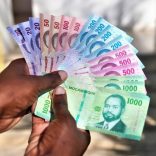Mozambique: Government expects to spend 7.4% GDP on debt servicing in 2026
IMF trims GDP growth forecasts for Mozambique, other Portuguese-language countries in Africa

File photo: Lusa
The International Monetary Fund has lowered its forecasts for economic growth in Angola, Cabo Verde, Equatorial Guinea, Mozambique and Sao Tome and Principe, while maintaining the estimate it released in April for Guinea-Bissau.
According to the IMF’s latest World Economic Outlook report, released on Tuesday in Washington as part of the Annual Meetings of the IMF and World Bank, Angola’s gross domestic product is now expected to expand by 2.9 percent this year, as compared to the IMF’s April estimate of 3.0 percent.
In the same vein, the Fund forecasts that Equatorial Guinea’s economy will grow 5.8 percent this year, slower than the 6.1 percent estimated in April, with the aggravating factor that the economic recession estimated for next year is now set expected to be worse, with the economy shrinking by 3.1 percent rather than from 2.9 percent. If that turns out to be correct, it means that GDP growth in the newest member of the Community of Portuguese-Language Countries (CPLP) has been negative on average for the past decade.
Mozambique and Sao Tome and Principe’s 2022 growth rates are seen at 3.7 percent and 1.4 percent, respectively, rather than the 3.8 percent to 1.6 percent figures previously foreseen.
The Fund also estimates that Cabo Verde’s economy will grow by 4.0 percent this year, instead of the 5.2 percent forecast in April, while Guinea-Bissau is still forecast to grow by 3.8 percent,
Sub-Saharan Africa
For sub-Saharan Africa as a whole, the IMF has revised down its forecast, and now projects growth of 3.6 percent this year and 3.7 percent next, with average inflation accelerating to 14.4 percent.
“In sub-Saharan Africa, the growth outlook is slightly worse than the July forecast, with a decline from 4.7 percent in 2021 to 3.6 percent and 3.7 percent in 2022 and 2023, respectively, representing downward revisions of 0.2 and 0.3 [of a] percentage point,” reads the report.
This downward revision “reflects lower growth in trading partners, tighter financial and monetary conditions and a negative shift in the terms of trade in commodities,” adds the report, which estimate global economic growth at 3.2 percent this year, down 0.2 of a point from the IMF’s July forecast, slowing to 2.7 percent in 2023.
In the part of the report on sub-Saharan Africa, the IMF notes that there has been a “major revision” to the forecast for rising prices, estimating that inflation will rise to 14.4 percent this year from 11.1 percent last – that is, 2 percentage points more than the July forecast.
It justifies the changes with worsening global economic conditions, notably the impact of Russia’s invasion of Ukraine and the consequences for trade in food commodities in Africa.
“Overall, international inflation has risen, due to increases in energy and food prices for consumers, with war driving inflationary pressures,” reads the report, which points out that the sub-Saharan Africa region is particularly exposed to this negative development.
“Low-income countries where citizens were already suffering from malnutrition and excessive mortality before the war have suffered a particularly severe impact, with especially serious effects in sub-Saharan Africa, where food accounts for 40 per cent of the food basket and the contagion effect from global prices to food prices is relatively high at 30 per cent,” the IMF points out.
The rise in prices has prompted central banks around the world to raise interest rates, which in the case of countries in Africa has a doubly negative effect, as most external debt is issued in dollars, automatically making it more expensive if central banks raise interest rates.
“This has also pushed up spreads – the difference between the interest on public debt issued in dollars or euros in these lower-income economies, and interest in the US or Germany – in sub-Saharan Africa, the difference in spreads for more than two-thirds of sovereign debt securities exceeded the level of 700 basis points in August 2022, significantly more than a year ago,” the IMF warns.
The widening of this difference between what the US or Germany pay to issue debt, and what investors demand from African countries to buy public debt, has led many African countries to advocate a reallocation of Special Drawing Rights (SDRs) as a way to circumvent the difficulty of turning to international markets to finance the development of their economies.
GDP Growth / Source:: World Economic Outlook, October
GDP growth (%)……..2022…..2023
Angola……………………..2.9…….3.4
Cape Verde………………4.0…….4.8
Guinea-Bissau…….…….3.8…….4.5
Equatorial Guinea……..5.8……-3.1
Mozambique…….………3.7…….4..9
Sao Toe and Principe….1.4…….2.6
- To read, download the full IMF World Economic Outlook ‘ Countering the Cost-of-Living Crisis ‘ , please click HERE.












Leave a Reply
Be the First to Comment!
You must be logged in to post a comment.
You must be logged in to post a comment.